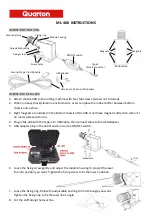
The Parallel Minor
A minor scale is said to be parallel to a major scale that begins on the same
note. The diagram below shows the relationship between relative minor, parallel
minor, and the major scale. Note that the relative minor scale has all the same
notes as the major scale, but the parallel minor does not.
C
D
E
F
G
A
B C
A
B C
D
E
F
G
A
C
D E<
F
G A<
B<
C
Relative Minor
to C major
Parallel Minor
to C major
(
Parallel Minor to A major)
Major Scale
A Minor
C Minor
C Major
A
B
C> D
E
F>
G> A
Major Scale
A Major
minor 3rd
minor 6th
minor 7th
R
2
3
<3
4
5
6
<6
7
<7
R
C
E<
F
G
G<
B<
C
C
D E<
F
G A<
B<
C
C Blues Scale
C Natural Minor
major 2nd
flatted 5th
minor 6th
R
2
3
<3
4
5
6
<6
7
<7
R
19
The Harmonizer shows the blues scale with dots under the appropriate windows. To
avoid confusion with the notes of the natural minor scale, the <5th of the blues scale
does not display in a window.
C
C
D
F
G
E<
A<
B<
Parallel Minor Scale
.
.
. . .
.
.
Flatted 5th of the blues scale does not appear in a window.
Dots indicate the notes of the blues scale.
The Blues Scale
The blues scale is so widely used that it bears mentioning even though its har-
monic structure does not belong to the diatonic system. There are several scales
that people call
blues,
but the most popular is a six-note scale that eliminates the
second and sixth notes and adds a flatted fifth to the natural minor scale.
Below is a comparison between the natural minor scale and the blues scale.
Special Note: The major keys of D<, G<, and C< do not have a parallel minor
associated with them, at least in name. The Harmonizer will display what looks
like a D< and G< minor scale, however they are not recognize according to
accepted notation practice. Conversely, the minor keys of A>, D>, and G> have
no parallel among the major keys.
















































